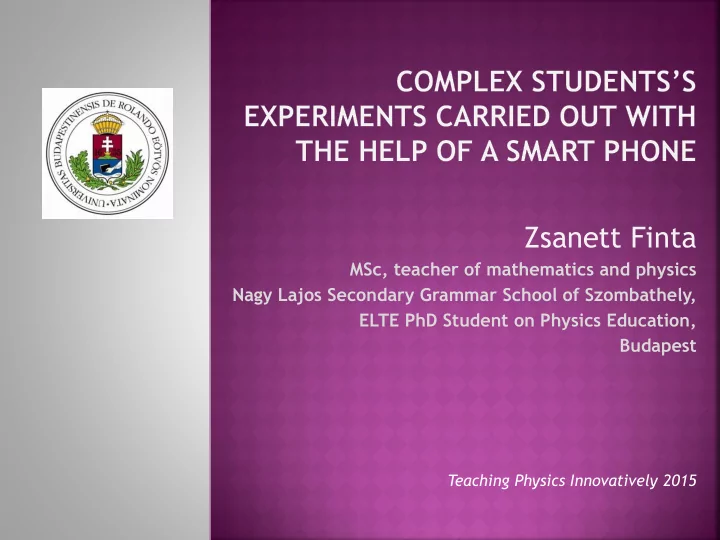

Zsanett Finta MSc, teacher of mathematics and physics Nagy Lajos Secondary Grammar School of Szombathely, ELTE PhD Student on Physics Education, Budapest Teaching Physics Innovatively 2015
Kinematics is an essential material Methods of tracing of motion → the classic methods and new modern techniques
The crucial role of physics experiments → "engine" of the research → practice deepen and stabilize → acquiring proficiency → developing practical skills → activity of students
The second Győr Science Festival Project-Based Learning (PBL) → the focus is on the student → motivation → cooperative work skills → coordinating and moderating role of teachers → interdisciplinary characterization
Mobile devices „Not without my mobile!” integral part of the daily lives the „ digital natives ” a new challenge of teachers integrate into classroom instruction
Databases and applications the Electro Droid and the Periodic Table scientific calculator functions the Pocket Physics Microphone the Sound Meter the FrequenSea Analyzer
The three-axis accelerometer sensor calculate the extent to which the phone is tilted determine the direction of gravitational acceleration rotation of the screen view the phone can be fixed to a small cart the phone can be placed on a vibrating or rotational systems export the measured data or do screenshot
Determine the telephone acceleration sensor location! examine uniform circular motion in real context use a record player (30 cm in diameter) Used application : Accelerometer Monitor Phone type : Sony Xperia SP the upper curve shows the measured data of the perpendicular to the axis of the figure in the middle the curve represents the tangential component of the acceleration of circular motion the bottom sequence gives the radial component of the acceleration
If we know the number of rotation, we can specify the angular speed ( 𝜕 ) The distance R of the revolving sensor from a central axis can be calculated as follows: 𝑏 𝑑𝑞 = 𝑆𝜕 2 → 𝑆 = 𝑏 𝑑𝑞 𝜕 2 Uniform circular motion with different frequences
1 1 𝑜 = 45 𝑔 = 0,75 → 𝑛𝑗𝑜 𝑡 𝜕 = 2𝜌𝑔 = 4,71 1 𝑡 𝑏 𝑑𝑞 = 𝑆𝜕 2 → 1,25 𝑛 𝑆 = 𝑏 𝑑𝑞 𝑡 2 𝜕 2 = = 0,056 m = 5,6 cm (4,71 1 𝑡) 2
Other additional tasks Determination of the spring constant Determination of the damping characteristics Definition of inertia Determination of resonant frequency Determination of acceleration due to gravity
A mobile phone was charged up with the help of 4 simple dynamos mounted on a bicycle and the necessary direct voltage was powered by 4 Graetz-bridges and the surplus current was used for operating a toy railway.
Conclusion particularly suitable for working in special students workshops or advanced level classes give the figures for students as homework a great advantage: it’s always in our reach the device doesn’t replace a well-stocked physics store room but only compliments i t
Special thanks for the help Péter Tasnádi Eötvös University my colleagues: Zoltán Kecskés Ferdinánd Valaska my students: Zalán Balhási Attila Németh Gergő Juhász Dávid Tóth
Thank you for your attention!
Recommend
More recommend